7 Building Considerations When Designing an Overhead Crane
What do you need to know before having a quote done for a new overhead crane? It is helpful to understand what a third-party company is looking for when evaluating your building during the quoting process.
“Nothing in life is to be feared. It is only to be understood. Now is the time to understand more, so that we may fear less.”
Nobel Prize-winning physicist Marie Curie sought understanding in life and her world-renowned work, and her words are as meaningful now as they were when first spoken. This is true also for the lifting and rigging business, especially when it comes to quoting out work.
You want to get the most value for your money when obtaining quotes for a new overhead crane system. When getting an accurate quote, it is important to understand the building’s:
- Space
- Structure
- Obstacles
- Other factors
- Getting accurate measurements
All of these factors will be considered when getting a quote for an overhead crane. In this article, you will learn what information is needed to create an accurate bid for your project.
What Do You Need to Know about Your Crane’s Width: Tapered Columns?
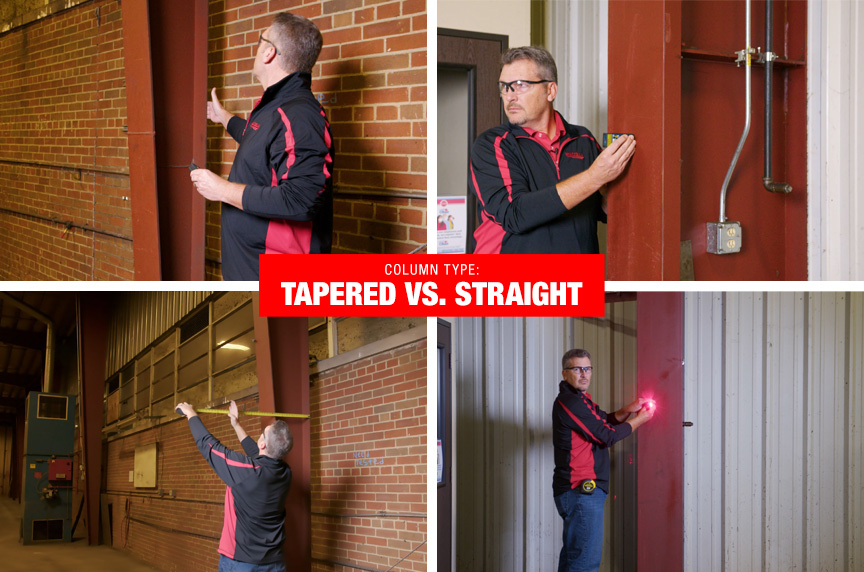
The Best overhead crane manufacturers will start their quoting process by examining the overall width of the area where the crane(s) will be installed. The measurement of the width will include the building columns so when approval drawings are created, you will get accurate information and be able to maximize your space.
A project lead will look at the overall width of this crane area, meaning the width between the inner-most parts of the building frames. For tapered columns, you’ll have less width in the crane bay the higher they go, so that needs to be factored in when determining crane span.
Example: If a tapered column is 30” at the top, you subtract 30” on each side of the bay, which adds up to 60” or 5’. That is how much less space you have in terms of bay width. Knowing this information will ensure you receive a more accurate quote for your overhead cranes.
What Do You Need to Know about Your Crane’s Width: Straight Columns?
Typical straight building columns are measured differently than tapered columns. For tapered columns, the salesperson will measure to the outside, and then, get the varying width differences between the top and bottom of the columns.
If it is verified that the columns are the same width at the top and bottom, measuring the width of the bay is much simpler. You’ll need to know what the furthest point in is on any width column because it reduces the clear area you will have to work with.
While doing the measurements for your new overhead crane, the third-party company will check the columns for issues, including, but not limited to:
- Obstructions
- Piping
- Conduit
- Any other attachments that affect where elements associated with the crane runway are placed
Basically, the person conducting the measurements is looking for anything that impacts where columns are set to support the runway system and the maximum height allowable to clear any overhead obstructions.
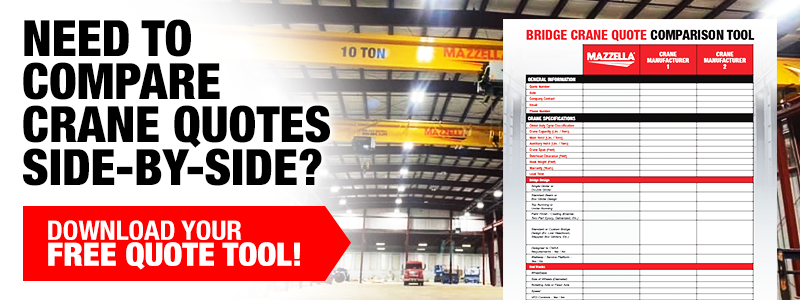
How Does Your Cement Floor Affect Your Overhead Crane Design?
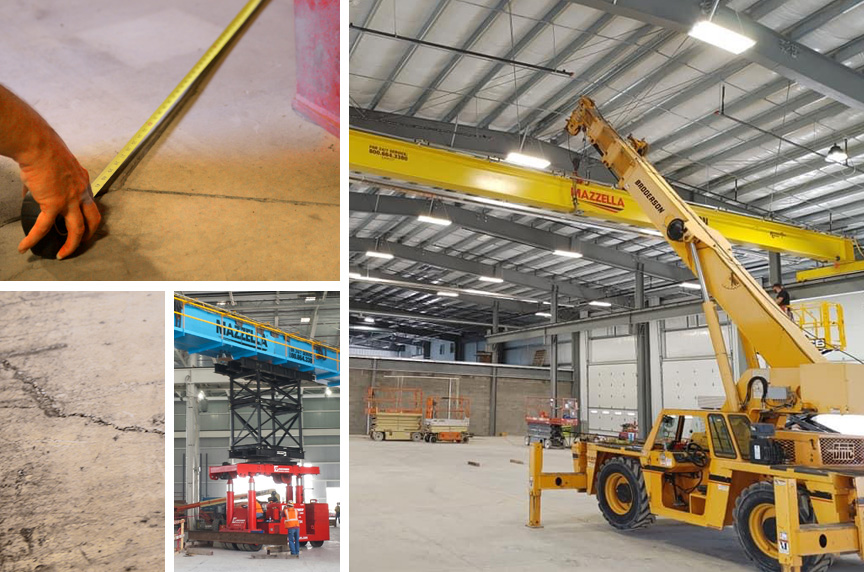
After seeing the path of the crane, a third-party company will look at the building columns and floor seams. This is done to find out if the floor seams are exactly the same, and if they join the columns in the same locations. Having a seam right in the middle of the column is good if that’s consistent all the way down the runway.
If the floor seam is exactly centered at the column, that is a best-case scenario because the system can straddle the seam with its anchors and baseplate. This prevents the need to offset the columns because the seam is either coming in off-center somewhere, or may even be a diamond seam.
When determining the cost of an overhead crane system, the location of the seams in your concrete slabs is another factor.
While studying the seams, a third-party company will look for any indications of cracking or inclusions that would cause an issue once runway column anchors are set. The third-party company will look at every single column to see if columns need to be offset. That will dictate what the base centers are to design the runway system.
In looking at the floor seam, they pay close attention for purposes of setting columns and knowing where anchors can be placed and columns located. They do not want to get anchors too close to the seams in the concrete.
Example: Say there is a crack that is 3’ away from the column and joins the seam. A support column for the overhead crane runway would be in close proximity to the crack in the concrete. That could cause you to need either a special column design or have to offset the column to that direction. Whether that’s possible or not depends on if it will impact the logistics of what you need for storage and material handling.
Diamond Seam
While straight seams come with one set of challenges, a diamond seam is different. If a diamond seam goes around a tapered column, it’s really not a concern. The tapered columns may bring out your crane columns beyond the point where the diamond joins the center seam in the floor. If that seam is centered with the column, that lets you know a runway column still can be put in line with the building column without the need to offset it.
If a straight column is in the same position with the same diamond, that would be a concern because it’s closer to where your runway column would actually sit on the floor. To measure the diamond, the third-party company will measure the length of the seam. These runway columns may require enlarged base plates with anchors spread out further to miss the seams in the floor.
When installing the anchors, the key is to put them in the floor in your base plate at places where they don’t get too close to any of the seams. If that isn’t accounted for, you’ll likely experience cracking from where you drilled going into a seam. That could cause additional settling or further cracking.
What Do You Need to Know About Your Building Columns?
Third-party companies will measure the flange width of the column. Also, they’ll measure the flange thickness to know what the tiebacks will be welded to for the floor-supported columns.
More often than not, tiebacks will need to be welded to the building column. Checking the thickness will help eliminate potential surprises during the installation process.
What Do You Need to Know About Your Crane’s Height?
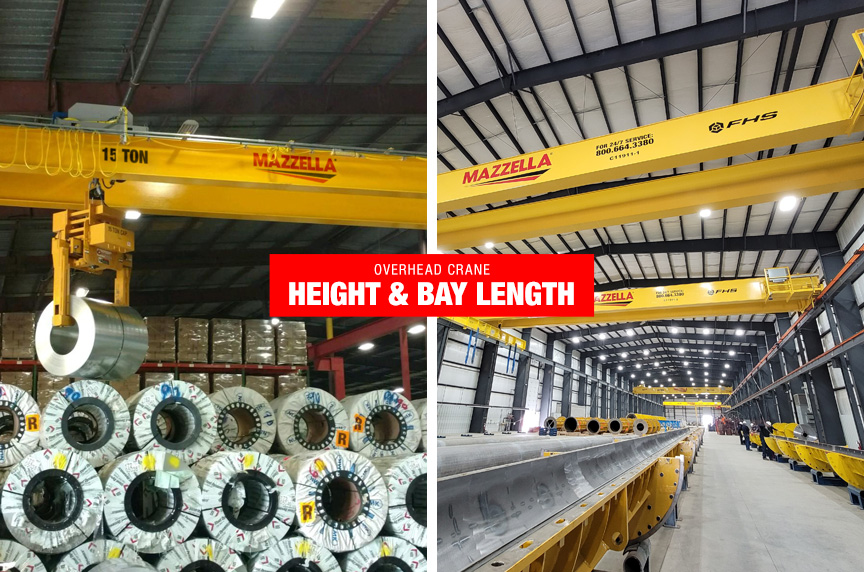
After checking the building column width and flange thickness, third-party companies will measure the clear height of the building columns.
The measurement of clearance height starts by finding the lowest part of the roof, and where it meets the column. Using a laser will give you a true measurement of the clear height from the floor up to the lowest part of the roof.
This information will allow the third-party company to figure out how tall the crane runway will be to avoid overhead obstructions like lights, ceiling fans, heaters, and any utility pipes that may interfere with the crane system.
What Do You Need to Know about Your Crane Bay Length?
After measuring the width and height of the crane bay, third-party companies will measure the bay’s overall length to figure out how long the runway can be.
In addition to the overall length, they will measure the center-to-center distances between each of the building columns. The hope is that all of the distances will be the same, but it is important for them to note any differences.
With tapered columns, it is important for them to note if they have a different length or width at the top. If you’re not dealing with different size columns with varying widths, that will help determine what your span is going to actually be.
They will take photos of any obstructions along the bay. Also, they will shoot photos of the general area of the crane, including from the floor to the roof, and from one end looking through the crane area to see everything as a whole. Having these photos will go a long way in making sure your project is accurately quoted. Additionally, Mazzella representatives often will put their phones on video mode and do a slow 360° rotation to encompass everything in the area.
Other obstructions to be aware of include:
- Low-hanging lights
- Overhead duct work
- Heater units
- Conduit running up the face of the column flanges
- Piping conduit
- Overhead ceiling fans
- Water supply lines
If any obstructions are present, they might need to be moved in order to attach and weld tieback braces to the face of those building columns. The key for noting the presence of any of these obstructions is to make sure there’s not a surprise during or after the installation.
Example: If your top unobstructed clearance is 20’2”, the top of the bridge crane can go no higher than 19’10”. OSHA (the Occupational Safety and Health Administration) requires a minimum of 3” of clearance over any moving item, including the bridge crane.
How Does Building Access Affect Your Crane Quote?
Locating the entry door closest to the crane’s intended location is the final step in the on-site evaluation.
If it is not in an ideal location, your cranes may have to be brought in using larger overhead doors in another part of the building. The salesperson will measure the width and height of the doors for the best options for bringing in the cranes to your building.
Example: If you have a 10’ door at the desired location for the overhead crane, it will be a tight fit to bring in beams on lifting equipment. Bridge cranes are either partially or fully assembled in a straight line. Having to fit in a small door or come in on an angle adds time and potential hazards to the install.
Also, additional equipment like manlifts, JLGs, etc. may be needed to lift and raise the crane beams into place.
How Can Mazzella Help You With Your Overhead Cranes?
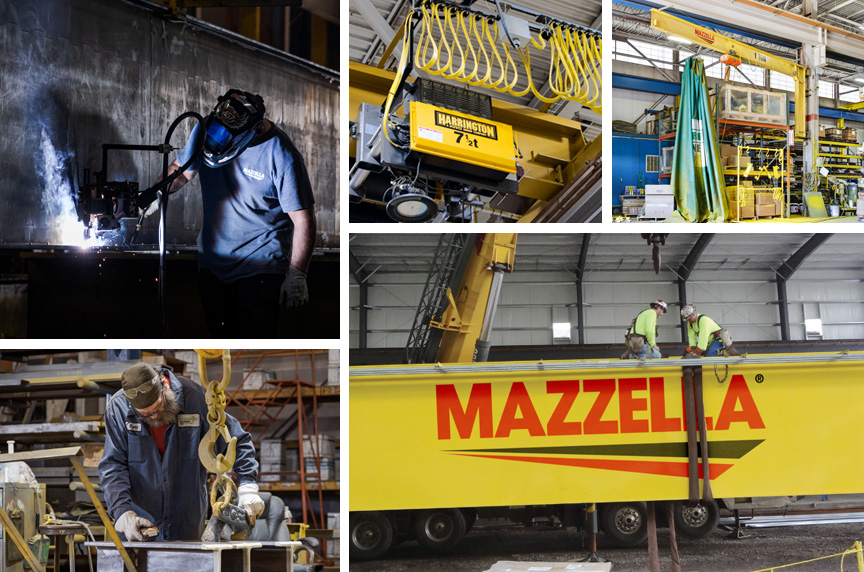
Mazzella is a leading manufacturer of world-class overhead cranes with over 65 years of experience. We engineer and build custom solutions ranging from light-duty, economical cranes up to large-capacity, high-duty-cycle cranes with welded plate-box girders.
Mazzella provides all types of overhead crane systems, including, but not limited to:
- Bridge cranes
- Gantry cranes
- Workstation cranes
- Jib cranes
- Monorail cranes
Mazzella has on-staff engineering and computer-aided design (SolidWorks) capabilities to build customized indoor cranes and runway systems to a lifting capacity in excess of 150 tons.
Our work is done in full compliance with standards from the CMAA (Crane Manufacturers Association of America, Inc.), NEC (the National Electrical Code), OSHA and ASME (the American Society of Mechanical Engineers). We have extensive electrical / control engineering capabilities, as well as AWS certified welders (AWS D1.1 and D14.1).
Additionally, we are an industry leader in hoist and overhead crane services. Our highly trained service staff specializes in solving complex problems in emergency situations. We find creative solutions to even the most challenging overhead crane service requirements. Our personalized approach to overhead crane and hoist maintenance is just one of the many benefits of our service team.
Mazzella strives to minimize your downtime. Our phones are answered 24 hours a day, 7 days a week, and we work on all makes and models of cranes and hoists. Mazzella has over 100 full-time technicians ready to answer the call at a moment’s notice.
Each of our trucks has a scissor lift, diagnostic equipment, tools and many of the parts that your crane or hoist needs to get back up and running. We carry VFDs (variable frequency drives), radio controls, contractors and much more!
Call us at 800.664.3380 or click here to speak with one of our Crane Specialists!
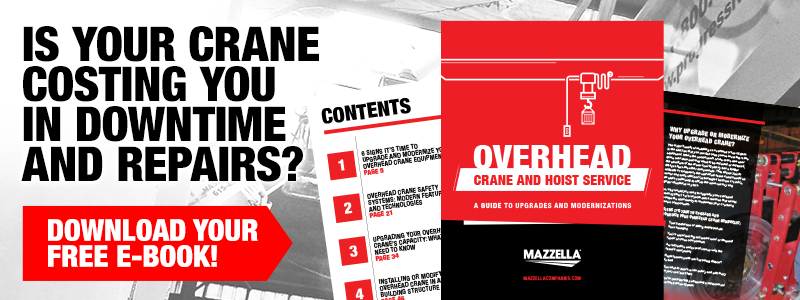

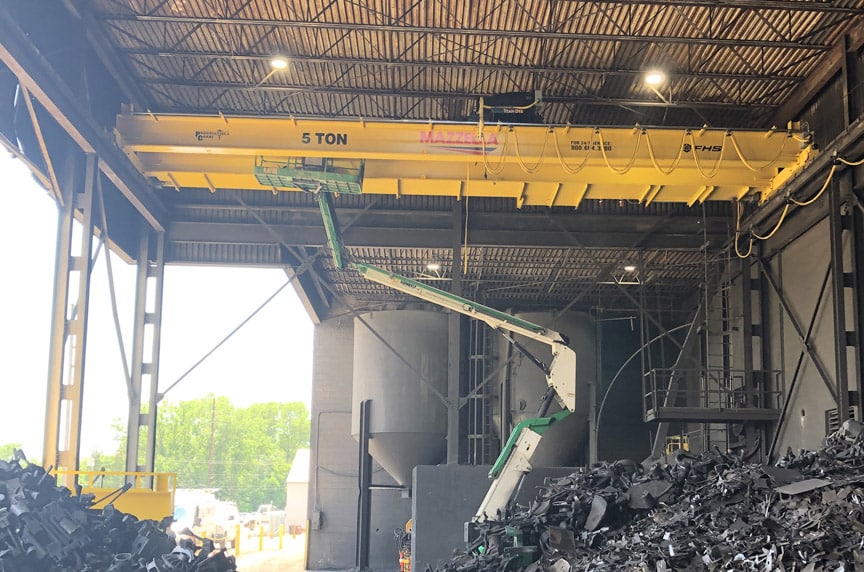
Overhead Cranes & Material Handling
Mazzella is a leading manufacturer of world-class overhead cranes with over 65 years of experience. We engineer and build custom solutions ranging from light-duty, economical cranes up to large capacity, high-duty cycle cranes with welded plate-box girders.
We provide all types of overhead crane systems, including bridge cranes, gantry cranes, workstation cranes, jib cranes, monorail cranes, and more!
Copyright 2022. Mazzella Companies.
